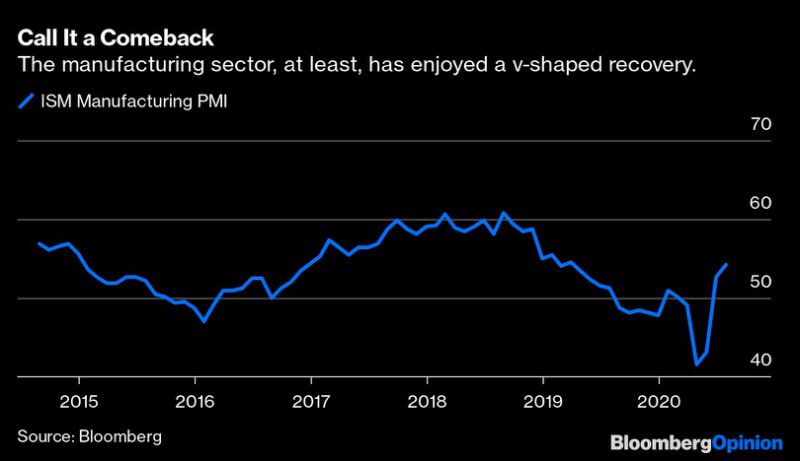Our Weird Pandemic Spending Ways Could Change Soon

(Bloomberg Opinion) — There’s been a lot of talk about the U.S. experiencing a K-shaped recovery, with large companies and the rich recovering while smaller companies and lower-paid service workers struggle. But this divide also shows up in the way Americans are shopping.
July personal spending data confirmed a simultaneous boom in consumption of durable goods such as cars and refrigerators and a depression in spending on services. This is the exact opposite of what happened in the 2008 recession. But such a durable-goods boom is unsustainable, whether or not we ever get a vaccine for the coronavirus. When it ends, markets might be in for a period analogous to 2015-16, when a slump in energy investment rattled global markets even as consumer spending and employment kept growing.
Big tech companies have gotten much of the credit for the surge in equities since March, but this durable-goods boom has played a role too. It’s why shares of home-improvement stores such as Lowe’s Cos. Inc. and Home Depot Inc., appliance makers such as Whirlpool Corp., electronics retailers such as Best Buy Co. Inc., and companies that sell home goods such as Williams-Sonoma Inc. and Wayfair Inc. have done so well.
Large increases in the ISM manufacturing survey, a measure of business sentiment, are often seen as indicative of economies exiting recession or enjoying accelerating growth. We’re getting such readings now. Most U.S. economic activity and employment is in services. But the ups and downs of the business cycle are usually more apparent in the goods sector.
There’s no historical parallel, particularly in a recessionary or crisis environment, for a surge in durable goods spending occurring simultaneously with a slump in services spending. In the past, durable goods have outperformed services only after a recessionary slump in spending on such big-ticket items.
This disconnect could continue for several more months. But the promise of rapid coronavirus tests, improved medical treatments and vaccines means there’s a good chance these trends revert to somewhat normal levels by early next year. How will markets digest a rapid increase in services spending while durable goods spending goes from robust to tepid or worse?
We have a recent example of an environment that was similar, if not identical, to what we might see over the next year or two. The plunge in commodity prices between 2014 and 2016 led to a slump in business investment around the world. Spending on commodity production and extraction — particularly oil — led to a drop in spending not just in those industries but also in the industrial supply chain supporting them.
Some have called this a stealth recession that occurred even in the context of a growing U.S. economy. Credit markets seized up, as investors worried about losses on loans tied to energy investments. Stock markets experienced plunges and higher volatility, as equity investors worried about the signals from credit markets.
It’s easy to see a dynamic like this returning in 2021 or 2022, if and when consumers shift spending from durable goods back to services. Investors, seeing negative data on big-ticket items, may freak out, believing the newfound softness is a recessionary leading indicator. That might hurt stocks, even as the service economy normalizes and starts hiring by the hundreds of thousands per month.
Reversing the unequal growth of the past several months will certainly be better for the economy in the long run. But there could be some anxious moments along the way, as a softening durable-goods sector and falling stock prices raise recessionary red flags that make investors overlook what is a natural part of economic normalization.
This column does not necessarily reflect the opinion of the editorial board or Bloomberg LP and its owners.
Conor Sen is a Bloomberg Opinion columnist. He has been a contributor to the Atlantic and Business Insider.
bloomberg.com/opinion” data-reactid=”44″>For more articles like this, please visit us at bloomberg.com/opinion
Subscribe now to stay ahead with the most trusted business news source.” data-reactid=”45″>Subscribe now to stay ahead with the most trusted business news source.
©2020 Bloomberg L.P.




